Very impressed, super quick delivery (arrived day after ordered and this was to a rural address!) and very competitive prices. Would very highly recommend to anyone looking for a company that ticks all the boxes![]()
Juicing vs. Blending: Which One Is Better?
My Natural Healths Juicer and Blender Specials
https://www.mynaturalhealth.co.nz/categories/view/kitchen-and-homeware
Here is a short comparison that explains the differences between the two as well as some of the specific benefits of each.
What’s The Difference?
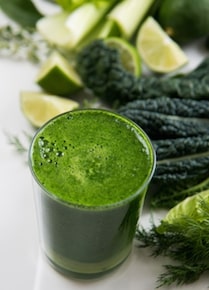
JUICING
Juicing is a process which extracts water and nutrients from produce and discards the indigestible fiber.
This is especially helpful if you have a sensitive digestive system or illness that inhibits your body from processing fiber. The fiber in produce helps slow down the digestive process and provides a steady release of nutrients into the blood stream. Jason Vale calls juicing "A nutrient express!"
Freshly squeezed vegetable juices form part of most healing and detoxification programs because they are so nutrient rich and nourish and restore the body at a cellular level.
A word of caution: When you remove the fiber from the produce, the liquid juice is absorbed into your blood stream quickly. If you are only juicing fruits, this would cause a rapid spike in blood sugar and unstable blood sugar levels can lead to mood swings, energy loss, memory problems and more!
Fiber is also filling and without fiber in the juice, some people tend to get hungry again quickly.
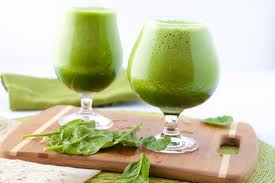
BLENDING
Unlike juices, smoothies consist of the entire entire fruit or vegetable, skin and all and contain all of the fiber from the vegetables.
However, the blending process breaks the fibre apart (which makes the fruit and vegetables easier to digest ) but also helps create a slow, even release of nutrients into the blood stream and avoids blood sugar spikes. Smoothies tend to be more filling, because of the fiber, and generally faster to make than juice, so they can be great to drink first thing in the morning as your breakfast, or for snacks throughout the day.
By including the fiber in your smoothie, the volume will increase. Also, you can pack more servings of fruits and veggies into a single serving of juice than you can into a smoothie.
Juicing and Blending Rules
1. It’s best not to combine fruits and vegetables (unless it’s apple). This can affect how well your digestive enzymes function.
This doesn’t seem to matter too much in green juices and smoothies, but vegetables like carrots, beetroots, broccoli and zucchini don’t combine well with fruit due to their high starch content. In his book Food Combining Made Easy, Dr. Herbert Shelton explains that starchy foods have to be eaten alone because starches are digested with enzymes different from those used for any other food group. Combining starchy foods with fruit may cause fermentation and gas. However, Dr. Shelton found that green leafy veggies combine well with pretty much everything.
2. Try to drink your juice or smoothie straight away. After 15 minutes, light and air will destroy much of the nutrients. If you can’t drink it straight away, transfer to a dark airtight container until you’re ready.
Using The Right Equipment
To get the most benefit from your juices and smoothies, it’s important to use the right equipment. Invest in a good-quality juicer. Cheaper, centrifugal juicers introduce heat and oxygen and destroy the enzymes and nutrients in your fruits and vegetables. While it may cost you a bit more initially, a premium cold-press juicer will produce a superior-quality juice and allow you to extract more from your fruit and vegetables, saving expense in the long-term.
The machines themselves will also generally last longer. In contrast to the rough extraction of centrifugal juicers, mastication or cold-press juicers compress fruit and vegetables to ‘squeeze’ out their juice.
The same goes for a blender. You want a blender that is gentle on your produce and doesn’t heat up the enzymes as it’s pulling apart the fibres. We spend money on gadgets, clothes, restaurants and other luxuries so, if you can afford it, investing in your health by buying a quality juicer or blender is totally worth it.
Read our Juicer Buying Guide below and learn about the pros and cons of each type of juicer.
Why Juice?
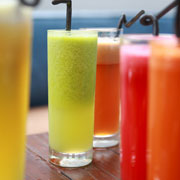 Fresh juice contains nature’s bounty of vitamins and minerals in a concentrated and highly bioavailable form. Whilst fiber is an essential component of healthy eating, its presence impedes digestion and nutrient absorption. As fiber is extracted during the juicing process, nutrients are maximally available to the body and rapidly flood the bloodstream with their healthful properties. Additionally, juices are most commonly consumed raw, without heat-induced enzyme damage.
Fresh juice contains nature’s bounty of vitamins and minerals in a concentrated and highly bioavailable form. Whilst fiber is an essential component of healthy eating, its presence impedes digestion and nutrient absorption. As fiber is extracted during the juicing process, nutrients are maximally available to the body and rapidly flood the bloodstream with their healthful properties. Additionally, juices are most commonly consumed raw, without heat-induced enzyme damage.
Whilst our dietary recommendations are to eat a minimum of five vegetable and two fruit servings per day, the sad reality is that many of us are failing to eat even half of that. Juicing is a wonderful addition to a high-fibre, healthy diet for added vitality and wellbeing. Fruit and vegetable juices can also be used to detoxify, lose weight and increase phytochemical consumption.
Where it began
 Norman Walker is credited with popularizing juicing and advocating its benefits during his long life of 99 years. He strongly promoted a raw food diet complemented with fresh fruit and vegetable juices for healing and optimal health. Believing that a healthy colon is fundamental to health, Walker recommended regular consumption of fresh juices for their colon-cleansing properties. His written work claims that old fecal matter putrefies in the unhealthy bowel, poisoning the bloodstream and contributing to numerous disease processes.
Norman Walker is credited with popularizing juicing and advocating its benefits during his long life of 99 years. He strongly promoted a raw food diet complemented with fresh fruit and vegetable juices for healing and optimal health. Believing that a healthy colon is fundamental to health, Walker recommended regular consumption of fresh juices for their colon-cleansing properties. His written work claims that old fecal matter putrefies in the unhealthy bowel, poisoning the bloodstream and contributing to numerous disease processes.
In spite of governmental objections to his unpasteurised juice products in the mid-1900’s, Walker designed a juicer which was later subsequently developed into the Norwalk Hydraulic Press Juicer. This continues to be a popular and respected product today.
Types of Juicers
There are many types of juicers available, with accordingly variable quality and price. A cheaper juicer may be an appropriate start for beginners and certainly preferable to not juicing if other models are unaffordable. However, a premium cold-press juicer will produce a superior-quality juice and allow you to extract more from your fruit and vegetables, saving expense in the long-term.
Centrifugal Juicers
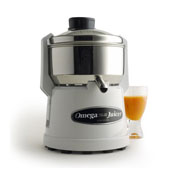 Centrifugal juicers are commonly available in retail outlets and are the cheapest to purchase. These machines initially extract juice by pulverizing fruit and vegetables against a round cutting blade that spins very quickly against a metal strainer. The centrifugal force generated by this cutting apparatus separates the juice from the pulp, which drains away separately from the fibrous remnants.
Centrifugal juicers are commonly available in retail outlets and are the cheapest to purchase. These machines initially extract juice by pulverizing fruit and vegetables against a round cutting blade that spins very quickly against a metal strainer. The centrifugal force generated by this cutting apparatus separates the juice from the pulp, which drains away separately from the fibrous remnants.
Advantages
- Generates large quantities of juice before pulp accumulates for removal
- Cheaper
- Easy to use
- May reduce food preparation time, as many will accept larger fruit and vegetable pieces
Disadvantages
- Noisy
- Yields less juice
- Destroys enzymes more easily by introducing heat and oxygen
- Extracts nutrients less efficiently
- Not well-suited to juicing greens
Cold Press Juicers
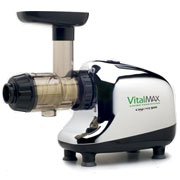 These superior machines operate via a mastication (chewing) or cold-press method. In contrast to the rough extraction of centrifugal juicers, mastication or cold-press juicers compress fruit and vegetables to ‘squeeze’ out their juice. Whilst more costly, their slower and more thorough extraction rates produce a high-quality juice – and more of it.
These superior machines operate via a mastication (chewing) or cold-press method. In contrast to the rough extraction of centrifugal juicers, mastication or cold-press juicers compress fruit and vegetables to ‘squeeze’ out their juice. Whilst more costly, their slower and more thorough extraction rates produce a high-quality juice – and more of it.
Advantages
- Quieter
- Lower heat and oxidation, thereby protecting nutrients and enzymes
- Well-suited to juicing greens and sprouts
- Yields more juice
- Juice preserved in better condition for longer
- Less foam
- Often able to serve other food processing functions, such as making nut butters, pasta and ice cream
Disadvantages
- Heavier
- More expensive
- Longer food preparation, as smaller food pieces are required for their narrow chutes
Manual Juicers
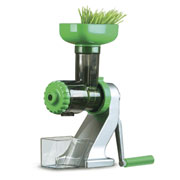 Like cold press juicers, manual juicers provide a slow and gentle extraction that preserves the nutritional integrity of juices. However, there are several features to consider before purchasing a manual juicer:
Like cold press juicers, manual juicers provide a slow and gentle extraction that preserves the nutritional integrity of juices. However, there are several features to consider before purchasing a manual juicer:
Advantages
- Quiet
- Operate without electricity
- Produce a high-quality, high-yield, nutritious juice
- Easy to clean
Disadvantages
- Slow
- Require some physical exertion
- May rust if iron-based
- Often limited to certain types of fruit and vegetables
For a list of our juicer products please go to
https://www.mynaturalhealth.co.nz/categories/view/kitchen-and-homeware
This article appeared on the food matters website and is sourced from:
Source Links:
http://www.thewellnesswarrior.com.au/2011/08/juicing-versus-blending/.
http://www.drsearswellnessinstitute.org/blog/2012/04/12/juicing-vs-blending/
Comments on this post
There are no comments on this post... be the first to place a comment!



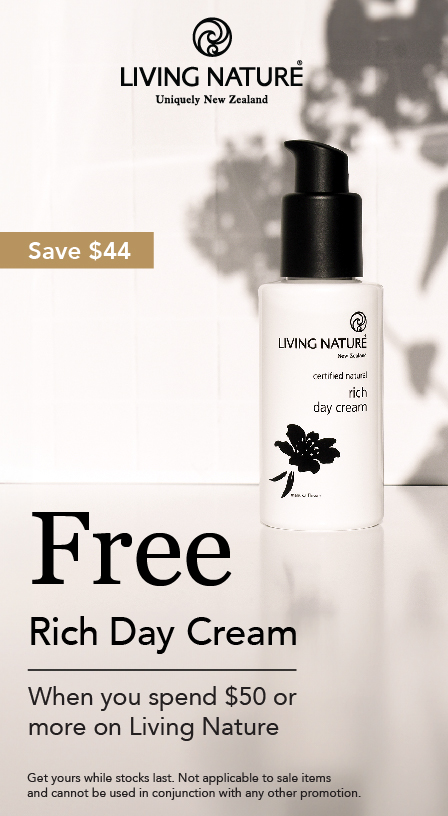

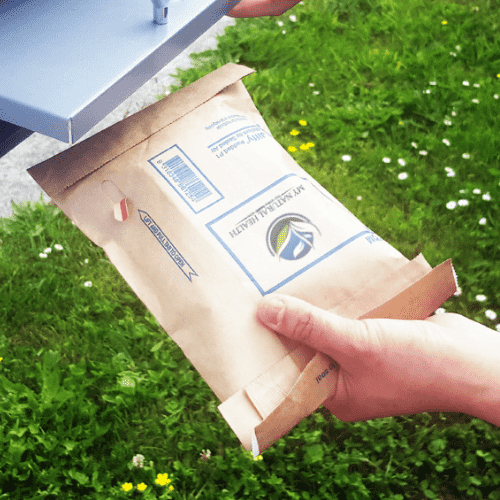

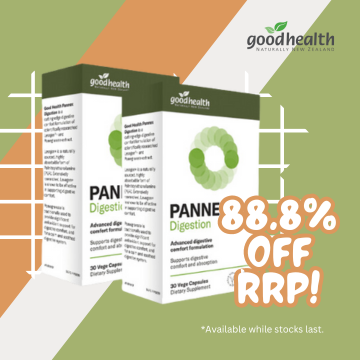
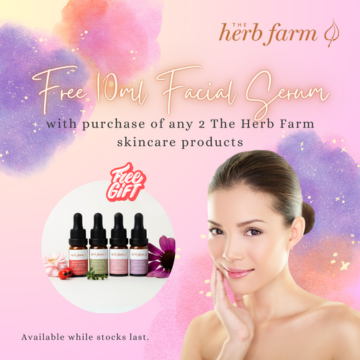











.png)